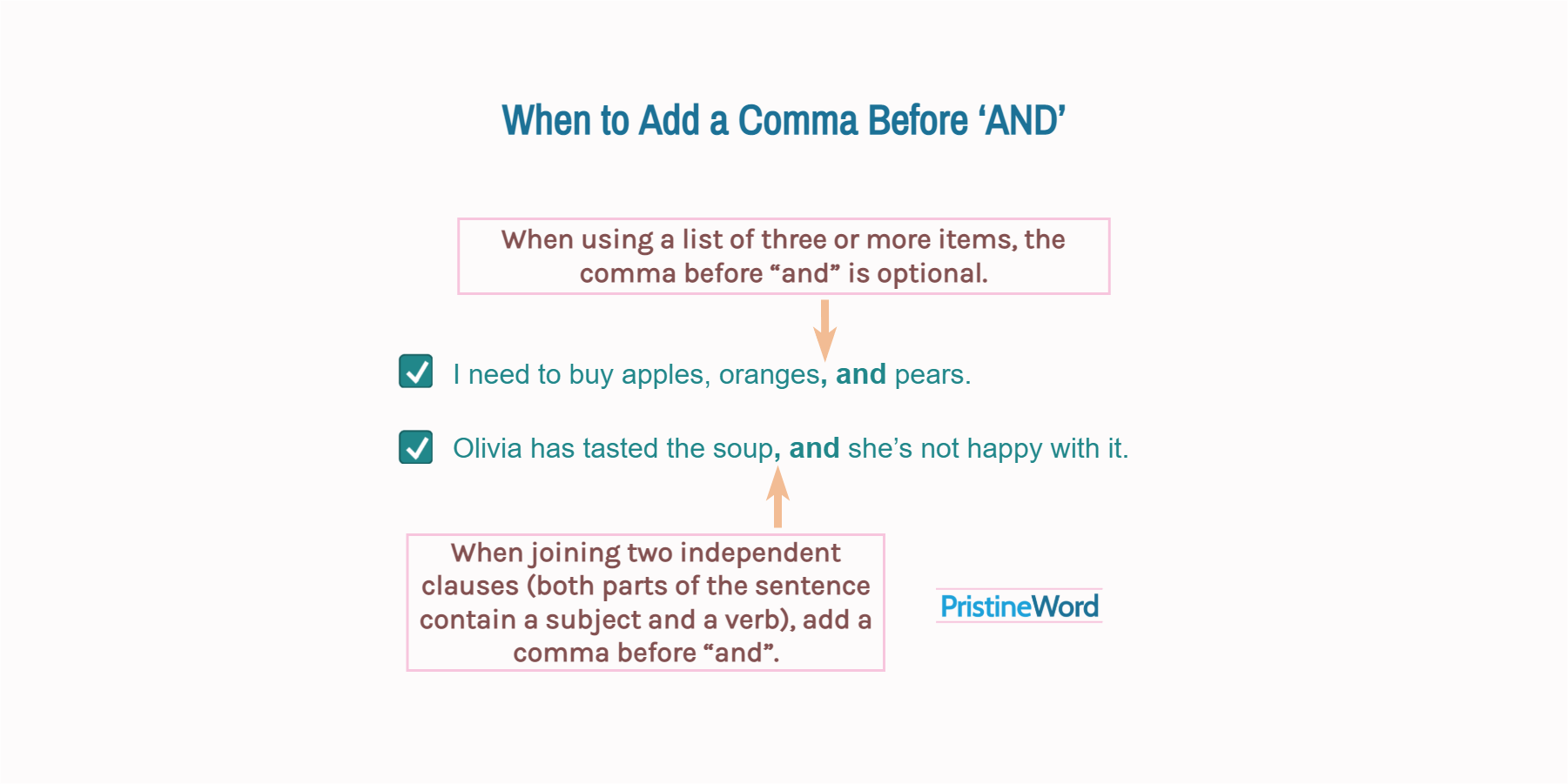When there are two items in a list, you should not use a comma before and. If the list has three or more items, the use of comma is optiona.
In a list of just two items, do not use a comma before “and”.
I need to buy apples and oranges.
I need to buy apples, and oranges.
In a list of three or more items, the comma before “and” is optional.
I need to buy apples, oranges, and lemons.
When joining two independent clauses (both parts of the sentence contain a subject and a verb), add a comma before “and”.
I went to the movies, and my brother decided to stay home.
I went to the movies and my brother decided to stay home.
If the subject does not appear in front of the second verb, the comma is generally unnecessary.
I need to wash the dishes and take out the trash.
Exceptions? Always use a comma to clarify (avoid confusion).
Contents
1. Comma Before 'And' in a List
1.1 Lists of Two Items
Do not use a comma before “and” if a list contains two items or groups of words:
They like watching dolphins and whales
They like watching dolphins, and whales
I hate doing laundry and cleaning bathrooms.
I hate doing laundry, and cleaning bathrooms.
A list can contain longer groups of words. In such a situation, you can add a comma to clarify so that the reader can spot the two elements more easily. For example:
England and Denmark and Italy and Spain will play for a place in the final.
England and Denmark, and Italy and Spain will play for a place in the final.
Three more examples where no comma is required:
I love cats and dogs.
My sister is very intelligent and competent.
High and increasing public debts are only sustainable in a low-interest rate environment.
1.2 Lists of Three or More Items
Using a comma before “and” in a list of three or more items is often optional.
I had bacon, eggs, and a cup of coffee.
I had bacon, eggs and a cup of coffee.
This comma is known as the Oxford comma or serial comma. Many fiction and nonfiction authors prefer the Oxford comma.
The young man loves watching dolphins, seahorses, and whales.
By contrast, a wide range of magazines and newspapers tend to omit it.
The suspect went to the mall, ate at the food court and went home.
It is a stylistic choice whether to use the Oxford comma. However, it is important to be consistent and avoid switching back and forth, except when the omission of the Oxford comma could cause uncertainty or confusion
The ingredients of my recipe are eggs, chocolate and peanut butter and sugar.
The ingredients of my recipe are eggs, chocolate and peanut butter, and sugar.
The comma after "butter" makes clear that "chocolate and peanut butter" represents a unit (a previously prepared ingredient).
2. Using a Comma to Separate Clauses and Phrases
2.1 Add a Comma Before 'And' to Join Two Independent Clauses
An independent clause is a group of related words that can form a complete sentence standing alone and contains a subject and a verb.
My father plays the piano, and my mother plays the guitar.
The sentence above has two clauses:
- "My father plays the piano."
- "My mother plays the guitar."
They are independent clauses; both contain a subject and a verb and express a complete thought.
When two independent clauses are joined by “and”, put a comma at the end of the first clause.
Olivia has tasted the soup, and she’s not happy with it.
Olivia has tasted the soup and she’s not happy with it.
Exceptions? If both clauses are very short, it is acceptable to omit the comma.
Mary writes and John reads.
More examples:
Where are they? John is visiting his aunt, and Paula went to the dentist.
It is nearly half past seven, and I haven't finished my homework yet.
The soup tasted too salty, and the cake was too sweet to eat. John is a terrible cook!
2.2 You Can Omit the Comma If the Subject Is Not in Front of the Second Verb
If the subject of the second clause is not in front of the verb, a comma is generally unnecessary.
Rebecca played the piano and sang slowly.
There are situations, however, where you may need a comma to avoid ambiguity:
Olivia saw that John was cheerful and went home.
Olivia saw that John was cheerful, and went home.
The comma clarifies that Olivia is the one who went home. Without the comma, the reader is liable to think that John went home.
More examples where no comma is necessary before "and":
He is tall and plays basketball.
I want you to go to the market and buy some fruit.
I would like to go to Italy and eat real, authentic Italian pizza.

